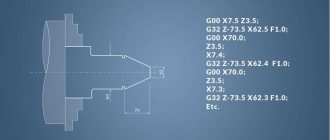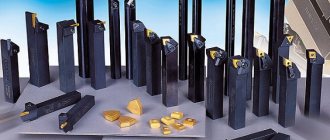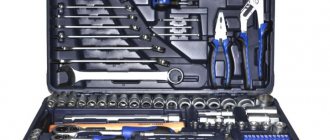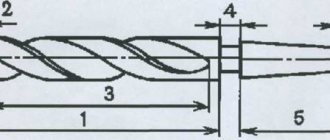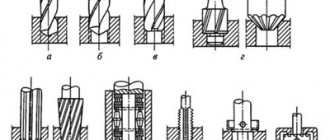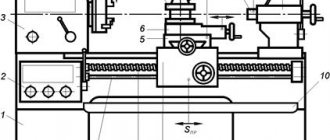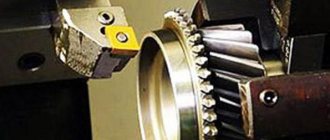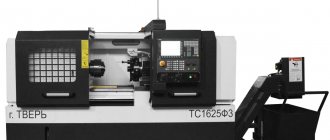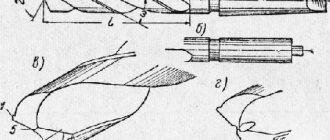Turning of a conical surface, the generatrix of which has a length exceeding 15 mm, is often accompanied by the appearance of vibrations. This leads to the appearance of waviness on the treated surface. Vibrations increase with increasing length and decreasing diameter of the part.
The surface of the workpiece may become wavy if the cutter overhang is large or if its fixation is unsatisfactory. True, vibration does not occur in all cases (for example, a rigid part with a generatrix of short length and a large slope angle is being processed). In such situations, there is a high probability of tool displacement due to the cutting forces acting on it in the absence of proper support or an excessively large overhang. In both cases, the angle of inclination will be different from the required one.
Due to the short length of the cutting edge, the cutter is quite difficult to install on the machine. Lack of straightness of the tool blade leads to deviations of the hole from the desired shape. It should be noted that the cutter must be installed at the level of the centers of the machine.
Machining holes in the form of cones with an installed tool is feasible if:
- the length of the cone generatrix is a maximum of 15 mm;
- the workpiece is highly rigid;
- the cone to be ground is located close to the fixed part of the product;
- the cone has a large angle of inclination;
- the workpiece is not subject to increased requirements regarding accuracy, straightness and quality of machining of the hole.
To check the slope of a cone made with a cutter, you can use a special template.
Required Tools
Professional metal drills (for example, Bosch, Makita, Metabo or Hawera) are made exclusively from high-speed steel HSS. Some are coated with a protective layer, which increases their wear resistance when drilling.
Hand tools - drills and drill bits should be selected carefully. If you have no experience in this area, you should seek advice from a store employee. Purchasing an expensive, high-end drill does not always guarantee its long service life.
Compliance with the technology for making holes in metal and a correctly selected drill significantly increases its service life and protects against premature wear. Basic rules for operating cutting tools:
- Selecting the appropriate type of gimlet for drilling metal of a certain hardness. Many manufacturers have developed entire programs using which you can select the appropriate tool.
- Selecting cutting modes, setting the correct rotation speed.
- Correctly selected feed, application of appropriate pressure on the cutting tool.
- Application of cooling. An oil-based emulsion is recommended.
- Proper fastening of the material (for example, in a vice).
- Attaching the drill to the stand is precise and perpendicular.
- Use of an expanded set of gaskets when drilling through holes.
Technological process
Drilling is the process of removing small parts of the material being processed, chips, using a drill. During drilling, the temperature of the workpiece increases. The cutting force leads to damage, the friction force causes a change in the geometry of the cutting edge, plus high temperature, as a result the tool gradually becomes dull.
Most drills are made from high-speed steel with varying cobalt content. It is very important that it is sharpened correctly: the cutting edges are of equal length, the jumper between them is located along the axis of the cutting tool.
This ensures that both edges will perform identical work during the drilling process. The drill will not have runout, the hole diameter will correspond to the size, and heating of the part and the tool will be minimized.
A drill-drill with chamfer correction has a smaller jumper, due to this the cutting edges are lengthened. With such drills you can drill a hole without preliminary marking with a core.
The choice of drills depends on the type of work being performed . NWKa HSS Baildon drills are optimal for drilling:
- structural steel;
- cast iron;
- brass;
- bronze;
- aluminum;
- plastics;
- tree.
Performing a machine deployment
The choice of modes for carrying out such a technological operation involves the use of special tables. The following parameters are used as initial parameters: material for making the reamer; grade of alloy being processed; diameter of the hole being created. The main characteristics of machine reaming include: the speed of rotation of the machine spindle, as well as the speed of penetration of the tool into the socket. This operation is carried out at a minimum speed when holes in viscous alloys/metals are processed. Reaming of nests in normalized steels is usually carried out at the maximum speed possible according to the technological map.
Types of coolant used
The cutting fluid is matched to the material in which the hole to be reamed is made. Expert recommendations on this issue are formulated as follows:
- tool steel alloys (with a content of the element carbon C exceeding 0.7%), structural alloys of various quality and carbon (the content of the element carbon reaches 2.14%) - a mixture of mineral or petroleum oils; oils with sulfur additives (element S); emulsion, including those based on a 2-phase system; soap solution (water);
- bronze – coolant is not used when deploying;
- aluminum – rapeseed oil (rape seeds are used as a raw material for its production); a mixture of turpentine (scientifically called turpentine oil) with kerosene; refined kerosene; emulsion;
- copper and copper-containing alloys – emulsions;
- cast iron - kerosene is used as a coolant. It is possible to deploy this material without coolant.
Some nuances of the machine deployment procedure
Before you begin machine reaming a hole, special attention should be paid to preparing the equipment. It consists of performing the following actions:
- the seat in the spindle of the unit, as well as the cone-shaped shank of the tool, are wiped with maximum care;
- then the reamer must be inserted into the prepared spindle;
- The part to be processed is fixed on the machine table. In this case, it is necessary to ensure that the axes of the hole and the reamer coincide;
The machine deployment procedure itself includes the following steps:
- upon completion of creating a socket in the workpiece, you need to remove the drill from the spindle of the drilling unit and insert a rough reamer in its place;
- a rough deployment operation is carried out;
- then you need to replace the rough development with a finishing one, and then perform the procedure again;
- Having completed the finishing deployment, it is necessary to remove the tool from the working area, turn off the electric motor of the machine and, using a plug gauge, check the quality of the work performed.
Sometimes it is recommended to mount the reamer in a hinge-type mandrel or a floating chuck for finishing machining.
Drilling metal
A special feature of the drills is the presence of a sharp edge, which allows for mechanical processing of the material. They have an equal diameter along the entire length, and the blade is sharpened at an angle of 118°. The sharpening angle varies depending on the hardness of the material, for example, for alloy steel, it is 135°. This type of drill is made of HSS steel with 5% cobalt. During operation, they require cooling with special drilling oil .
In order to drill a nozzle in metal evenly and accurately, it is necessary to use a guide device - a jig.
When drilling, it is best to use as little force as possible. When drilling a through hole, when the moment of exit of the cutting tool approaches, it is necessary to reduce the feed so that the part does not tear out, the drill does not break, or burrs do not form.
A conical drill is used to produce a conical hole in metal. It is used as an independent tool. They can drill a cylindrical hole, turning it into a conical one. A conical hole in the metal is made on a lathe in order to drill and bore the resulting nozzle with a cutter.
Cutting modes
The most common mistake is using too high a drilling speed . The more difficult the material to process, the lower the drilling speed should be used. For example, in the case of drilling an 8 mm hole in brass, the drilling speed should be 2500 rpm, for harder alloy steel - 800 rpm. The best sign that the drilling speed is correct is nice, long chips.
Depending on which tool to choose, cutting parameters are important. It is necessary to select the correct rotation speed and feed. Bench-top drilling machines provide the best parameters, but they cannot be used everywhere. It is necessary to follow the principle: the lower the speed and the lower the feed, the longer the tool will last.
For example, take stainless steel, 8mm hole, 4mm thickness, cooling lotion or oil, HSS drill bit, drill or drilling machine: The revolutions should not exceed 400 rpm, and the feed should not be more than 0.10 mm/ turnover In other words, you can drill at a speed no higher than 400 rpm. But this speed is not optimal. Therefore, it would be optimal, for example: 170 rpm, and the feed for every 30 revolutions is 1 mm (three times less than recommended).
Cooling the drill during the drilling process is very important. Use emulsions, oils, drilling sprays. Water should be avoided, as it does not have the properties of lubricating fluids, but only cools.
Large diameter holes
To the question of how to drill a large diameter hole in metal, there is only one answer: in the technological process of drilling necks . For example, you need to increase the neck and get a size of thirty millimeters in diameter. First, it is drilled with a tool of a smaller diameter, for example, four millimeters, then to a size of 8 millimeters, then 12 millimeters, and so each size is expanded to the result.
A large diameter neck in a product can be made on a lathe. The operation is as follows: drilling a hole, boring the neck of the desired size. As pre-drilling is required, the process can be divided into stages: small-diameter drilling, reaming with a gradual increase in drill diameter.
Drilling thin sheet metal
The peculiarity of obtaining an armhole in a thin sheet of metal is its reliable fastening . After the drill comes out to the other side, there is a danger that the sheet may suddenly jam and tear out if it was held in your hands. The best way to securely fasten a sheet is a clamp. In this case, the risk that the tin will be torn out is much less. The number of burrs formed is reduced, which will greatly facilitate the finishing of the element.
Read also: Titanium processing at home
If the metal is 0.1 millimeter thick, you can make a hole without a drill by using a metal punching tool. Its design is very simple, like pliers. A punch is attached to one lever, and a matrix to the other. The principle is the same as cold stitching using a stamp.
To cut a through groove in sheet steel, you need to drill a successive row of holes according to size, connecting them into a single slot using a chisel and hammer. To do this, it is necessary to cut off the bridges between the holes and smooth out the unevenness with a file.
Metal pipes
When drilling a metal pipe, make sure that the workpiece is securely secured in the vise. It is advisable to mount the drill on a vertical stand. Insert a piece of wood of the same shape and size inside the pipe, which will protect the pipe from deformation. In this case, use low feed.
Getting narrow nozzles
Drilling deep holes of small diameter can only be done on a special machine or lathe using a device. The part is clamped into a 3-jaw chuck and checked for runout with an indicator. The device is mounted on a tool holder. A drill chuck with a drill is installed in the fixture. First, the hole is centered, then the nozzle is drilled to a given depth. Using a tailstock is problematic, since it needs to be constantly removed to remove chips and lubricant.
To obtain vertical holes, a right angle drilling device is used. For an electric drill, this is a vertical stand at an angle of 90 degrees to the base. The easiest way is to use a vertical drilling machine.
The working area of a cone drill (also known as a “step drill”) is a spiral-shaped recess with several annular transitions of different radii. This device, due to such design features, makes it possible to determine at any stage of processing what size the hole is.
At first it seems that the use of conical step drills, which are characterized by an increased price, is inappropriate, since it is always possible to take a drilling tool of a specific radius and use it to make the desired hole. However, they have some advantages that make their use worthwhile in a variety of situations.
Reaming Tapered Holes
The processing scheme for cone-shaped sockets is practically identical to the operation of reaming holes with a cylindrical cross-section or having ledges due to the use of drills of different diameters. Carrying out this procedure with sockets of the last (stepped) configuration differs in that a smaller allowance can be left. Another feature is the use, along with roughing and finishing, of an intermediate tool.
The sequence of stages for deploying holes in a conical configuration is shown in the figure.
The results of such an operation are monitored using a conical metrological gauge. This check is performed:
- determining the depth of passage of the device used for control;
- according to the configuration of the lines of contact between the surfaces of the metrological gauge and the created hole.
The quality of the cone-shaped socket deployment procedure is checked as follows:
- No more than 3-4 lines are drawn with a pencil on the side face of the scaleless control instrument along its longitudinal axis. The distance between them should be approximately the same.
- Under slight pressure, a gauge is inserted into the conical hole of the workpiece and turned a third of a turn.
- After removing the control tool, the condition of the lines drawn at stage No. 1 is checked.
The fact of uniform abrasion of all the above lines indicates the high-quality implementation of the deployment procedure.
Scope of use, design
Conical drills have a long service life. This is due to high-strength cutting edges. The stepped tool makes it possible to carry out processing for which it would be necessary to use several ordinary drills. The high price of instruments in this group is mainly due to their versatility.
Twist drills with a conical shank make it possible to process parts at high speed. At the same time, the quality of the edge does not decrease at all. The product consists of the following elements:
- tip for preparatory drilling;
- transition with a bevel to eliminate burrs;
- cutting edge that widens the holes.
With a cone drill it is possible to make holes not only in metal, but also in plasterboard, wood, plastic, and other parts. The pointed end of the tool makes it possible not to use a centering device and can easily enter even dense material. The resulting hole does not need to be further processed using a needle file or grinding device.
The progressive recesses of the device, which are arranged in a spiral, are made in various sizes with a smooth transition. This design increases the efficiency of processing thin-sheet material with a twist drill with a conical shank by approximately fifty percent. Conical tools can be used both manually and when mounted on special equipment.
An abrasive consisting of diamond/titanium particles can be applied to the working area of a two-stage drill. There is no contradiction with the rules of GOST (state standard). This coating makes the cutting edges much stronger. Thanks to this, the conical drill does not need to be sharpened often. Of course, it is necessary to follow operating rules and not subject the tool to excessive loads.
A step drill for metal is often used to correct inaccuracies made when processing a part with another device (for example, torn edges). A product with a conical shank is indispensable if you need to drill holes in thin sheet material or fiberglass parts. The versatility of step devices allows us to say with complete confidence that they will definitely come in handy both in production and in your workshop.
Manual conical reamer and other types of devices
In order to obtain holes with a clean surface, or if a precise fit of the hole is required for some kind of ground part, a process called reaming is performed. It can be done manually or you can use a drilling machine on which reamers are installed. In the first case, during work, a manual conical reamer is rotated with a crank.
These tools are cylindrical, conical and stepped (according to the type of hole they process). In terms of accuracy, they are divided into the following: those indicating quality (for cylindrical reamers), those indicating quality (roughing, finishing and intermediate between them - for conical types). This also includes cylindrical reamers with a calibrated allowance, which are necessary in order to further grind the tool to the desired size. And the last type in this group is adjustable reamers.
According to the way they are clamped, they are divided into:
- manual (they have a square tail for a knob),
- machine (with a cylindrical or conical shank),
- attachments for machines (installed on a special mandrel, as a rule, needed for large tools).
The working part of this device has cut teeth, usually from 6 to 14, along which there are grooves that form cutting edges.
The part that is located at the bottom of the reamer is designed to remove chips, and the part at the top, called the calibrating part, can launch the tool in the desired direction to completely calibrate the holes. In general, a tool is needed in order to ream tapered holes. The allowance allowed during the roughing stage of work is no more than a fifth of one millimeter, and for the finishing stage it is taken equal to a tenth of a millimeter.
Exploitation
Step drills are optimally suited for drilling holes in tubular products, sheets of steel and non-ferrous metal, and plastic workpieces. Their use allows you to perform several procedures in 1 pass. When making a pass, the burrs are cleared, holes of various sizes are centered and drilled. Cone tools have a special tip, thanks to which they do not slip/slip even on significantly protruding areas.
Experts say that using step drills is very convenient. When using them, various auxiliary items are not required. There is also no need for additional alignment. An ordinary drilling device can go sideways when processing a part. Because of this, the hole will be made unevenly, and additional alignment will have to be done. The conical shank does not deviate anywhere when drilling, the hole is made evenly and smoothly.
General concepts about taper
The surface of the cone consists of the following quantities (Fig. 1): section D is larger and section d is smaller.
Between the two surfaces formed by sections D and d, there is a distance I. α is the slope angle of the cone, 2α is the angle of the cone. Rice. 1. Cone geometry
The ratio K=(D – d)/I shows the taper of the object. When written, it is indicated with a division symbol or a decimal fraction. For example: 1:20, 1:50 or 0.05, 0.02.
The relation Y=(D – d)/(2I) = tanα is called slope.
How to choose?
It is necessary to choose a drill with a conical shank only after you know its basic parameters. You can learn a lot about an instrument by paying attention to its shade.
- A gray tint indicates that the tool has not been heat treated and is therefore of low quality.
- The dark shade indicates that the drill was processed with hot steam and is quite durable.
- The golden color indicates that there are no internal stresses in the drill material. This ensures improved performance.
- The bright gold color means that the tool is very wear-resistant. This is due to titanium nitride, which is contained in steel. The rather high price of such drills is explained by the long operational period.
To make a drill with a conical shank, different types of metal are used. The material is indicated in the labeling. If a drill is marked with HSS, it means it is capable of processing a part at high speed without deforming. Also, its strength does not decrease with strong heating.
When choosing a step drill for metal, you need to take into account the following characteristics:
- radius. The determining factor here is the size of the holes you plan to create;
- manufacturer. The performance indicators of the product and its price depend on it; compliance of the purchased tool with GOST;
- the ability to sharpen the product many times. Here you need to rely only on your preferences and skills.
Read also: How to sharpen a garden hacksaw
How to sharpen it yourself
Cone drills provide the ability to drill holes with a radius from 0.2 to 1.6 cm. They are manufactured in 2 versions. One of them can be sharpened, the other cannot. The increased price of tools that belong to the second type is due to their high strength.
The cutting edge of such drills (if you follow all operating rules) does not deform for a long time. It is worth noting that an attempt to sharpen such drills for metal will most likely lead to them becoming unsuitable for subsequent use. First, you should study the technology of sharpening a conventional drill, and then take on a similar tool.
To properly sharpen a drilling tool, you need to watch a special video and listen to the advice of professionals. To sharpen a step drill, you do not need a drawing. You can simply restore the original geometry of the drill.
It is possible to sharpen a step drill using a special machine device that is equipped with an abrasive wheel. The working area of the circle should be covered with ordinary sandpaper. In addition, you can use diamond stones of small thickness, which are often used for sharpening knives, scissors, and other objects.
Restoring the geometry of conical tools, the guide recesses of which are located rectilinearly, can be done manually. If they are arranged spirally, it is necessary to use a sharpening machine device. Remember that the better the quality of the drilling tool, the easier it is to sharpen it.
Operating principle
The use of a reamer makes it possible to obtain internal surfaces with an accuracy grade of 6-9 and a roughness Ra of 0.32–1.25 microns. High-class characteristics are achieved due to the design of the tool with a large number of cutting edges, which can be from 4 to 14 pieces.
The quality of processing when performing a deployment operation is determined by a set of factors:
Surface roughness classes
- The size of the allowance removed during processing;
- Machine cutting conditions;
- Quality of workmanship and sharpening;
- Features of geometry and design;
- Type of material being processed.
The deployment process goes like this. A cutting tool of the required diameter is brought to the edge of the hole. Then it receives a cutting movement, which, with manual and mechanical feed, consists of rotation of the tool and feed along the axis of the hole.
The amount of allowance in tenths or hundredths of a millimeter is the difference between the diameter of the hole and the selected tool.
Cylindrical and conical holes are processed by reaming using hand and machine tools of the appropriate shape.
Reamer is a cutting tool that is needed for finishing holes
Price, selection tips
If there are no difficulties with the acquisition of ordinary spiral tools, the landing area of which is made in the shape of a Morse cone, then with a conical product the situation is somewhat different. Its price depends on 2 key characteristics: working size and the metal from which it is made.
A buyer who intends to buy two-stage drills may be confused by the widely varying prices. To clarify this issue, we need to consider price examples. Drills designed to create holes with a radius of 0.2 to 1 centimeter have a fairly low cost (400-500 rubles). Russian conical tools, which allow you to create holes with a radius of 0.2 to 1.5 centimeters, cost almost 2 times more (one thousand one hundred rubles).
The price of a product greatly increases if it belongs to a popular brand. For example, the cost of conical drills from, the radius of which is from 0.2 to 1 centimeter, is equal to two thousand nine hundred rubles. A device that makes it possible to create holes with a radius of 0.3 to 1.9 centimeters costs about five thousand rubles. You can also purchase a set of Bosch drilling tools, which allows you to drill holes with a radius from two to fifteen millimeters. It will cost approximately ten thousand rubles.
Many companies that sell conical devices provide them at a fairly high cost, without in any way confirming their high quality. When buying a drill from such companies, as well as from those that provide tools at a low price, you need to prepare for the fact that the product parameters will be far from ideal. In view of this, you need to purchase tools only from those organizations that have all the required certificates. In addition, it is worth considering how the tool is marked. Products that have indicators that meet the requirements of GOST and have the necessary certificates must be marked accordingly. So, if you want not to make a mistake when choosing a drilling tool, carefully study the markings of the drills. This will allow you to buy a product that best suits your needs.
We also recommend reading:
A good craftsman should know what smooth conical and stepped metal drills are intended for. If this is the first time you’ve heard about this type of cutting equipment, then it’s time to understand the purpose, types and design features. Step cone drills replace a series of cutting attachments, so having the equipment is always useful.
Deployment - what mistakes should not be made?
To obtain the cleanest possible surface, as well as to cool the tool during operation, the holes that were made with a drill in the steel product are lubricated with mineral oil. If the working surface is copper, the hole is treated with emulsion, with aluminum - with turpentine, and if it is brass or bronze, the holes are left without lubrication, since they unfold in a dry state.
High quality of the machining process can be achieved if the reamer has quite a lot of edges cutting the metal. It is thanks to this tool that you can remove a small allowance. After all, by removing a small thickness of metal, you can achieve fairly high accuracy.
A common mistake is the wrong choice of tool for reaming: many people choose a countersink instead of a reamer for this purpose. This is a semi-finish tool that is not capable of showing greater accuracy, it has fewer cutting sharpenings, and in general it is intended for other purposes. Therefore, you need to be careful when choosing a tool. And within one type of tool, you should choose the type wisely.
What is a cone drill and what are they for?
A cone drill is an attachment for a power tool, consisting of two parts - a cone-shaped tip and a cylindrical or hexagonal shank. Devices are classified into two types - smooth and stepped. A smooth conical drill has a wall shape corresponding to the design, and a stepped drill has the shape of steps.
Cone-shaped elements are used for drilling round holes in different materials - metal, wood, plastic. For such purposes, cylindrical drills are used, you say. So why are cone devices needed? They are used for drilling holes in sheet steel, as well as similar structures made of non-ferrous metals - aluminum, copper and brass. The presence of one conical drill replaces a whole set of cylindrical cutting devices - this is the main difference.
Differences between a smooth conical and a stepped drill
Before we find out the scope and advantages of cone devices, let’s look at their varieties. Smoothing elements in the form of a cone drill thin sheet steel, gradually increasing the size of the hole. To drill a hole of the required diameter with such a drill, you need to periodically stop and take measurements. Some manufacturers of smooth-bore cone drills eliminate this drawback by applying digital markings.
Stepped elements allow you to drill a hole with greater accuracy due to the presence of degrees. When drilling, there is a smooth transition through the steps, and as a result, the operator can easily track what diameter the hole has. It should be noted that cone drills are quite expensive. Their price ranges from 2 thousand rubles or more. It all depends on the material of manufacture, as well as the size of the holes being drilled. Many people may think that cone devices are completely useless equipment from China until they test the cutting tool in action. Craftsmen openly declare that if frequent drilling of thin-sheet materials is necessary, it is recommended to use conical cutting attachments.
Where are cone drills used?
Cone drills are used for drilling holes of different diameters in thin sheet materials. Moreover, the resulting holes are distinguished by such advantages as evenness and accuracy without scoring, chips or burrs. You can drill through thin-sheet material with a regular cylindrical drill, but the quality of the work will suffer and the task will also become more complicated. For example, the slightest deviation of the drill from the surface will result in a triangular or oval hole rather than a round one. In addition, burrs, scuffs and chips are formed, which ultimately negatively affects the quality of the work performed.
Read also: Rotary hammer device and principle of operation
The use of conical drills can significantly simplify the work, eliminating all the disadvantages of cylindrical devices. Due to its advantages, the equipment has found its application in various fields:
- Automotive and repair
- Landscape design
- Construction
- Installation of plumbing equipment
- Installation of electrical installations
The device is not effective in situations where you have to drill holes in materials whose thickness is more than 10 mm.
What are the advantages of cone drills?
Like all types of cutting tools, cone drills have their own characteristic advantages. The advantages of using the devices in question include:
- Possibility of drilling holes of different diameters using just one nozzle
- Wear resistance - unlike cylindrical elements, conical elements have a long service life. The cutting edges of the nozzles have high strength values, so the device wears out very slowly
- Speed - the nozzle allows you to quickly drill holes, which has a positive effect on its service life. The cutting edges do not have time to heat up, so their quality does not decrease
- There is no need to pre-punch the material, since the tip of the cone drill easily cuts into any metal, even with a dense structure
- At the same time, it plays the role not only of a tool for drilling holes, but also as a grinding material
- Improves the quality and efficiency of drilling thin sheet material
- Eliminates the possibility of deformation of the drilled sheet, which is associated with a smooth transition with increasing diameter
- Possibility of using the attachment not only on stationary drilling equipment, but also on drills
- The presence of abrasive coating increases the strength and efficiency of the equipment. Cone drills can be coated with titanium or diamond
- Does not require frequent sharpening
Cone drills make it possible to drill large-diameter holes, thereby eliminating the need to use metal crowns. This type of cutting attachment is suitable not only for drilling holes in sheet materials, but also corners, pipes, profiles, etc. The main condition is that the thickness of the steel should not be more than 7 mm, and ideally no more than 4 mm.
Stepped types of nozzles are classified according to the type of edge into spiral and straight. The straight edge design has the advantage of being easier to sharpen than the spiral edge design. Spiral types of edges are characterized by softness and smooth movement of the drilling device.
Deployment Methodology
To fully understand the methodology for carrying out this procedure, it would be advisable to give a specific example. Let it be necessary to create a hole with a diameter of Ø30.0 mm according to qualifications IT6 – IT7. The sequence of steps for completing this task looks like this:
- First, a socket with a diameter of Ø28.0 mm is drilled;
- then the countersinking operation is carried out using a countersink with a diameter of Ø29.60 mm:
- further – rough reaming using a tool with a diameter of Ø29.90 mm;
- finishing reaming using a finishing reamer with a diameter of 30.0 mm
The degree of accuracy of the hole formed as a result of this procedure, as well as the level of roughness of the resulting surface, is influenced, along with the geometric characteristics of the tool used, by the type of coolant (hereinafter, Lubricant and Coolant). If holes are drilled into steel structural elements, special disperse systems are used, in other words, emulsions with mineral oil additives. When parts made of brass and bronze are processed, coolant without such components is used. This topic will be discussed in more detail below.
What you need to know to choose a cone drill
In shape and design, conical drills differ significantly from cylindrical ones. Like cylindrical devices, conical devices are similarly fragile and require careful handling. To select cone devices for the appropriate work, you must consider the following recommendations:
- Attachment color - if you are choosing a core drill, then you are probably presented with models that differ in color.
If the seller says that there is no difference between the devices, then he does not understand this. The black part indicates that the nozzle has undergone additional heat treatment. Such devices have a long service life. The golden color means that the nozzle is coated with titanium nitride, which increases its strength properties. Steel-colored products do not have any coating, and they are not subjected to heat treatment, therefore, compared to previous options, they last the least - Marking - indicated directly on the outside of the equipment (on the shank).
By the marking you can understand what the nozzle is made of, as well as its diameter and accuracy class. Often the marking begins with a letter designation, and begins with the letter “P”. This letter indicates that high-speed, high-strength alloy steel is used to produce the cone drill. After the first letter, the second letter with a numerical value is indicated. The number indicates the percentage of the alloy, for example, M - molybdenum, F - vanadium, K - cobalt, A - nitrogen. The marking also contains the designation of the minimum and maximum diameter, as well as the accuracy class. Equipment with a diameter of up to 2 mm is not marked. The drill may be marked HSS type, which means high-speed steel
The marking after the HSS designation may also indicate additional information:
- HSS-E is a high-speed steel, which is an analogue of the domestic material P6M5. Designed to work with low carbon steels and cast iron, as well as hard alloy and stainless steel devices
- HSS-Co - 5% cobalt is added to the alloy
- HSS-G TiN - sustainable materials for processing titanium products
To work with conical drills, stationary drilling machines or two-handed drills are used. How to properly drill holes with cone drills is described in detail in the material.
How to properly drill holes with a cone drill instructions
To learn how to drill correctly with cone drills, you must first prepare the necessary tools and materials. For work you will need the following materials and tools:
- Blank for drilling. These are sheet steel, plastic, glass, wood, etc. The workpiece must be securely secured in the jaws of a vice or a clamp.
- Drill - any power tool that can develop a rotation speed of 3-5 thousand revolutions per minute is suitable. In this case, it is recommended to attach an additional handle to the drill, which will avoid distortion. Drilling is performed in non-impact mode
- Cone drill of suitable diameter. Depends on the hole that needs to be drilled in the workpiece
After this, we proceed to the actual work. The drilling instructions are as follows:
- The nozzle is fixed in the tool chuck
- Select the location where you want to drill a hole
- The tool is applied to the surface being processed strictly in a perpendicular direction
- The tool motor starts. The first seconds of drilling into metal help center and cut a small hole. As soon as the drill begins to go deeper into the hole, the diameter increases with each subsequent revolution. At the same time, the speed of work execution increases
- The end result is a neat hole without chips, burrs or other defects.
It is enough to try the attachment in action once and then stop using cylindrical drills when processing sheet materials. How a conical drill shows itself in action when drilling plastic, plexiglass, metal and other materials is shown in the video clip.
Working with hand tools
Manual deployment involves performing the following steps:
- the parameters of the initial hole and those specified by the T.Z. conditions are analyzed. its final technical characteristics;
- based on the data obtained, a tool is selected for carrying out the preliminary roughing and final finishing deployment procedures;
- the workpiece is firmly fixed in a vice;
- a tool is installed into the hole made in the workpiece at the casting stage or by drilling it, with which the rough reaming operation will be performed;
- then a collar is put on its shank;
- then a special lubricant is applied to both working surfaces - the inner hole being machined and the outer reamer;
- the next stage is the actual rough deployment. It is carried out by slow rotation, without any sudden movements. In this case, it is necessary to constantly apply lubricant material;
- At the end of this stage, the instrument should be carefully removed. This must be done so that it does not turn in the opposite direction;
- then a finishing tool is inserted into the hole, and a wrench is mounted on its square shank;
- finishing deployment is carried out by rotating the knob in a clockwise direction. To obtain a surface with a low level of roughness, the tool feed intensity should be very low, or even better, the minimum allowed according to the technological map;
- After completing the final reaming procedure, you need to check the quality of the machined surface and the correctness of the hole geometry. For this purpose, a scaleless device such as a smooth limiting metrological plug gauge is used.
The figure shows the techniques for carrying out the deployment procedure.
